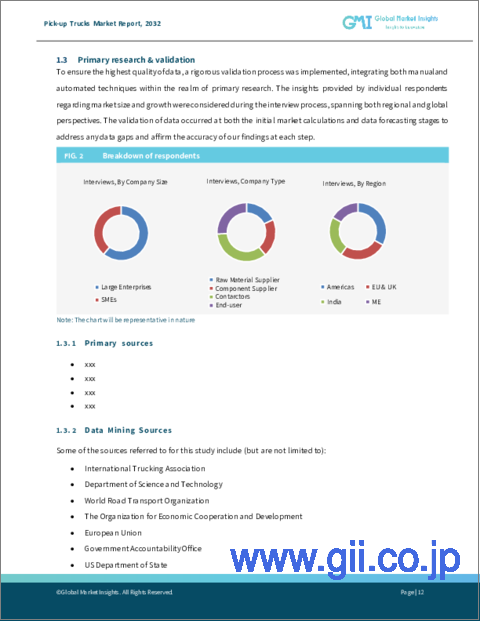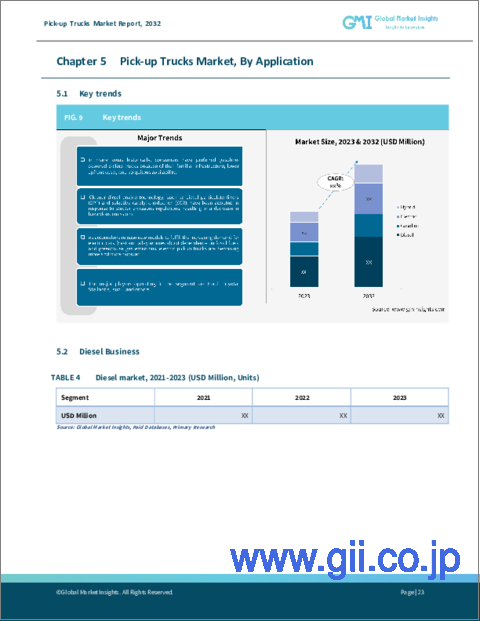|
|
市場調査レポート
商品コード
1472018
ピックアップトラック市場規模:車両別、燃料別、用途別、成長見通し、地域別展望、世界予測、2024年~2032年Pick-up Trucks Market Size - By Vehicle (Compact, Mid-size, Full-size, Heavy-duty), By Fuel (Gasoline, Diesel, Electric), By Application (Commercial, Industrial), Growth Prospects, Regional Outlook & Global Forecast, 2024 - 2032 |
||||||
カスタマイズ可能
|
|||||||
| ピックアップトラック市場規模:車両別、燃料別、用途別、成長見通し、地域別展望、世界予測、2024年~2032年 |
|
出版日: 2024年02月19日
発行: Global Market Insights Inc.
ページ情報: 英文 220 Pages
納期: 2~3営業日
|
- 全表示
- 概要
- 目次
ピックアップトラック市場は、建設、農業、物流など様々な分野における実用車の需要増加により、2024年から2032年にかけて5.5%以上のCAGRを記録すると推定されます。
例えば、Toyo Tire U.S.A.は2024年3月、エネルギー、鉱業、建設、農業、林業用の未改良道路で高荷重下でのトラクションを提供する商用小型トラック用タイヤToyo M655を発売しました。さらに、オフロード走行、キャンプ、アウトドア・アドベンチャーといったレクリエーション活動へのシフトの高まりが、冒険愛好家やアウトドア愛好家の間でピックアップトラックの需要を押し上げています。
現代のピックアップトラックは、最先端の技術、快適な設備、安全機能を備えており、従来の商用ユーザーだけでなく、より幅広い層にアピールしています。さらに、ハイブリッドや電気ピックアップトラックモデルのイントロダクションは、環境持続可能性への関心の高まりに対応し、効率的で環境に優しい輸送ソリューションを求める環境意識の高い消費者を引き付けています。
ピックアップトラック産業は、車両、燃料、用途、地域によって分類されます。
燃料に関しては、ガソリン・セグメントはディーゼル・セグメントと比較して競合価格となっており、幅広い消費者にとってより利用しやすくなっているため、2024年から2032年の間に市場シェアは顕著な牽引力を持つと思われます。強力な進歩により、燃料効率と性能が向上し、運転コストと環境への影響に対する懸念に対処できるようになりました。さらに、給油インフラにガソリンを利用できるようになったことで、特に都市部や郊外での普及が進み、消費者の利便性が向上しています。
用途別では、さまざまな産業分野で多面的な用途があるため、産業セグメントのピックアップトラック市場は予測期間中に大きな成長を遂げると思われます。これらの車両は、比類のない多用途性、耐久性、積載能力を提供するため、建設、農業、鉱業、物流に携わる企業にとって不可欠な資産として機能しています。また、困難な地形を移動し、重い荷物を効率的に運搬する強力な能力により、ピックアップトラックは現場での機器、資材、機械の運搬に欠かせないものとなっています。
欧州のピックアップトラック産業規模は2024年から2032年の間に急速な拡大を遂げると考えられています。都市化とインフラ開発プロジェクトの増加により、多様な地形に対応し、効率的に物資を輸送できる多用途の車両が必要とされています。厳しい排ガス規制は、よりクリーンで燃費の良いピックアップトラックの採用を奨励しており、ハイブリッドモデルや電気モデルの需要を押し上げています。さらに、充電インフラを強化し、持続可能なモビリティ・ソリューションを推進するための自動車メーカーと地方自治体の戦略的協力関係は、この地域の市場成長をさらに加速させると思われます。
目次
第1章 調査手法と調査範囲
第2章 エグゼクティブサマリー
第3章 業界洞察
- 業界のエコシステム分析
- サプライヤーの情勢
- 原材料メーカー
- 部品メーカー
- 製造業者
- 流通業者
- エンドユーザー
- 利益率分析
- 技術とイノベーションの展望
- 特許分析
- 主要ニュースとイニシアチブ
- 規制状況
- 影響要因
- 成長促進要因
- 業界の潜在的リスク・課題
- 成長可能性分析
- ポーター分析
- PESTEL分析
第4章 競合情勢
- イントロダクション
- 企業市場シェア分析
- 競合のポジショニング・マトリックス
- 戦略展望マトリックス
第5章 市場推計・予測:車両別、2018年~2032年
- 主要動向
- コンパクト
- ガソリン
- ディーゼル
- 電気自動車
- 中型
- ガソリン
- ディーゼル
- 電気
- フルサイズ
- ガソリン
- ディーゼル
- 電気
- ヘビーデューティー
- ガソリン
- ディーゼル
- 電気
第6章 市場推計・予測:燃料別、2018年~2032年
- 主要動向
- ガソリン
- ディーゼル
- 電気
第7章 市場推計・予測:用途別、2018年~2032年
- 主要動向
- 商業用
- 産業用
第8章 市場推計・予測:地域別、2018年~2032年
- 主要動向
- 北米
- 米国
- カナダ
- 欧州
- 英国
- ドイツ
- フランス
- イタリア
- スペイン
- ロシア
- 北欧
- その他欧州
- アジア太平洋
- 中国
- インド
- 日本
- 韓国
- ニュージーランド
- 東南アジア
- その他アジア太平洋
- ラテンアメリカ
- ブラジル
- メキシコ
- アルゼンチン
- その他ラテンアメリカ
- 中東・アフリカ
- 南アフリカ
- サウジアラビア
- アラブ首長国連邦
- その他の中東・アフリカ
第9章 企業プロファイル
- Ashok Leyland
- Changan Automobile Co., Ltd.
- China FAW Group Corp., Ltd.
- Dongfeng Motor Corporation
- Fiat Toro
- Ford Motor Company
- General Motors
- Great Wall Motors
- Honda Motor Co., Ltd.
- Hyundai Motor Company
- Isuzu Motors Ltd.
- Mahindra & Mahindra
- Mercedes-Benz Group
- Mitsubishi Motors
- Nissan Motor Co. Ltd.
- Ram Trucks
- Renault Group
- SAIC Maxus Automotive Co., Ltd
- Toyota Motor Corporation
- Volkswagen Group
Pick-up Trucks Market is estimated to register over 5.5% CAGR between 2024 and 2032, due to the increasing demand for utility vehicles across various sectors like construction, agriculture, and logistics. For instance, in March 2024, Toyo Tire U.S.A. launched the Toyo M655 for commercial light truck tire purposes to provide traction under heavy loads on unimproved roads for energy, mining, construction, agriculture, and forestry use. Additionally, the rising shift towards recreational activities, such as off-roading, camping, and outdoor adventures is boosting the demand for pick-up trucks among adventure enthusiasts and outdoor enthusiasts.
Modern pick-up trucks are equipped with cutting-edge technologies, comfort amenities, and safety features, appealing to a broader demographic beyond traditional commercial users. Moreover, the introduction of hybrid and electric pick-up truck models is addressing the growing concerns for environmental sustainability, attracting environmentally conscious consumers looking for efficient and eco-friendly transportation solutions.
The pick-up trucks industry is classified based on vehicle, fuel, application and region.
In terms of fuel, the market share from the gasoline segment will gain notable traction during 2024-2032, as they offer competitive pricing compared to their diesel counterparts, making them more accessible to a broader range of consumers. Strong advancements have led to improved fuel efficiency and performance for addressing concerns about operating costs and environmental impacts. Furthermore, the availability of gasoline for fueling infrastructure has turned more widespread, especially in urban and suburban areas, facilitating convenience for consumers.
By application, the pick-up trucks market from the industrial segment will witness significant growth in the forecast period, due to multifaceted utility across various industrial sectors. These vehicles serve as indispensable assets for businesses involved in construction, agriculture, mining, and logistics for offering unparalleled versatility, durability, and payload capacity. The strong ability to navigate challenging terrains and transport heavy loads efficiently also makes pick-up trucks indispensable for hauling equipment, materials, and machinery across job sites.
Europe pick-up trucks industry size will witness rapid expansion between 2024-2032. The increasing urbanization and infrastructure development projects are necessitating versatile vehicles capable of navigating diverse terrains and transporting goods efficiently. Stringent emission regulations are incentivizing the adoption of cleaner and more fuel-efficient pick-up trucks, thereby boosting the demand for hybrid and electric models. Moreover, strategic collaborations between automakers and local governments to enhance charging infrastructure and promote sustainable mobility solutions will further accelerate the regional market growth.
Table of Contents
Chapter 1 Methodology & Scope
- 1.1 Market scope & definitions
- 1.2 Base estimates & calculations
- 1.3 Forecast calculations
- 1.4 Data sources
- 1.4.1 Primary
- 1.4.2 Secondary
- 1.4.2.1 Paid sources
- 1.4.2.2 Public sources
Chapter 2 Executive Summary
- 2.1 Industry 360-degree synopsis, 2018-2032
Chapter 3 Industry Insights
- 3.1 Industry ecosystem analysis
- 3.2 Supplier Landscape
- 3.2.1 Raw material providers
- 3.2.2 Component providers
- 3.2.3 Manufactures
- 3.2.4 Distributotrs
- 3.2.5 End-user
- 3.3 Profit margin analysis
- 3.4 Technology & innovation landscape
- 3.5 Patent analysis
- 3.6 Key news & initiatives
- 3.7 Regulatory landscape
- 3.8 Impact forces
- 3.8.1 Growth drivers
- 3.8.1.1 Rising demand for transportation and distribution of goods
- 3.8.1.2 Growing technology advancements in pick-up trucks
- 3.8.1.3 Increasing demand for electric pick-up trucks
- 3.8.1.4 Rise in adoption of pick-up trucks in industrial sector
- 3.8.2 Industry pitfalls & challenges
- 3.8.2.1 High initial purchase price
- 3.8.1 Growth drivers
- 3.9 Growth potential analysis
- 3.10 Porter's analysis
- 3.10.1 Supplier power
- 3.10.2 Buyer power
- 3.10.3 Threat of new entrants
- 3.10.4 Threat of substitutes
- 3.10.5 Industry rivalry
- 3.11 PESTEL analysis
Chapter 4 Competitive Landscape, 2023
- 4.1 Introduction
- 4.2 Company market share analysis
- 4.3 Competitive positioning matrix
- 4.4 Strategic outlook matrix
Chapter 5 Market Estimates & Forecast, By Vehicle, 2018-2032 ($Bn, Units)
- 5.1 Key trends
- 5.2 Compact
- 5.2.1 Gasoline
- 5.2.2 Diesel
- 5.2.3 Electric
- 5.3 Mid-size
- 5.3.1 Gasoline
- 5.3.2 Diesel
- 5.3.3 Electric
- 5.4 Full-size
- 5.4.1 Gasoline
- 5.4.2 Diesel
- 5.4.3 Electric
- 5.5 Heavy-duty
- 5.5.1 Gasoline
- 5.5.2 Diesel
- 5.5.3 Electric
Chapter 6 Market Estimates & Forecast, By Fuel, 2018-2032 ($Bn, Units)
- 6.1 Key trends
- 6.2 Gasoline
- 6.3 Diesel
- 6.4 Electric
Chapter 7 Market Estimates & Forecast, By Application, 2018-2032 ($Bn, Units)
- 7.1 Key trends
- 7.2 Commercial
- 7.3 Industrial
Chapter 8 Market Estimates & Forecast, By Region, 2018-2032 ($Bn, Units)
- 8.1 Key trends
- 8.2 North America
- 8.2.1 U.S.
- 8.2.2 Canada
- 8.3 Europe
- 8.3.1 UK
- 8.3.2 Germany
- 8.3.3 France
- 8.3.4 Italy
- 8.3.5 Spain
- 8.3.6 Russia
- 8.3.7 Nordics
- 8.3.8 Rest of Europe
- 8.4 Asia Pacific
- 8.4.1 China
- 8.4.2 India
- 8.4.3 Japan
- 8.4.4 South Korea
- 8.4.5 ANZ
- 8.4.6 Southeast Asia
- 8.4.7 Rest of Asia Pacific
- 8.5 Latin America
- 8.5.1 Brazil
- 8.5.2 Mexico
- 8.5.3 Argentina
- 8.5.4 Rest of Latin America
- 8.6 MEA
- 8.6.1 South Africa
- 8.6.2 Saudi Arabia
- 8.6.3 UAE
- 8.6.4 Rest of MEA
Chapter 9 Company Profiles
- 9.1 Ashok Leyland
- 9.2 Changan Automobile Co., Ltd.
- 9.3 China FAW Group Corp., Ltd.
- 9.4 Dongfeng Motor Corporation
- 9.5 Fiat Toro
- 9.6 Ford Motor Company
- 9.7 General Motors
- 9.8 Great Wall Motors
- 9.9 Honda Motor Co., Ltd.
- 9.10 Hyundai Motor Company
- 9.11 Isuzu Motors Ltd.
- 9.12 Mahindra & Mahindra
- 9.13 Mercedes-Benz Group
- 9.14 Mitsubishi Motors
- 9.15 Nissan Motor Co. Ltd.
- 9.16 Ram Trucks
- 9.17 Renault Group
- 9.18 SAIC Maxus Automotive Co., Ltd
- 9.19 Toyota Motor Corporation
- 9.20 Volkswagen Group






